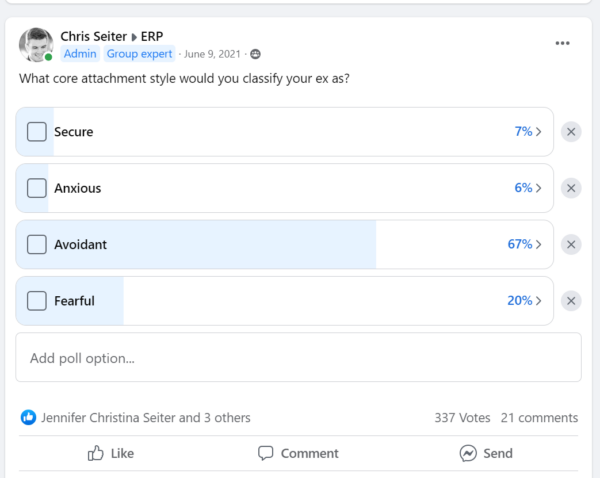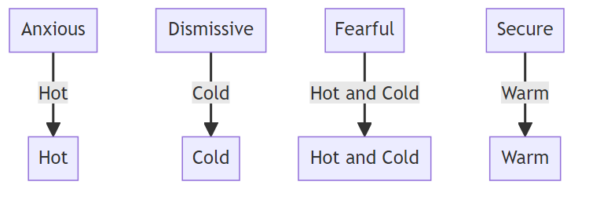Today we’re going to be talking about if fearful avoidants want you to reach out and honestly the answer is super simple,
A fearful avoidant will want you to reach out based on which of their core wounds is triggered.
The trick with this discussion is understanding why and that’s where this gets really fun because in order to do so we really need to dive in to the psychology of a fearful avoidant.
I’m going to be talking to you about things like,
- Why everyone is lying to you about fearful avoidants
- Understanding the Hot and Cold approach to fearful avoidants
- What everyone misses about the nurturing side to fearful avoidants
- The dual answer to if they want you to reach out to them
Let’s begin!

What Are Your Chances of Getting Your Ex Boyfriend Back?
Take the quizEveryone Is Lying To You About Fearful Avoidants:
So, the first thing that everyone always tends to talk about with fearful-avoidant individuals is the fact that they are incredibly rare.
I’ve even been guilty of this. You can actually look up some of the previous articles I’ve written for this website, where I’ve cited research that basically says they’re the most rare type of attachment style. And I still agree with that.
But lately, in our private community, we’ve had a lot of individuals say that their exes are fearful-avoidant as opposed to dismissive-avoidant. This made me question my assumptions.
Everyone always cites this 7% figure, right?
The Attachment Project Research
Even the Attachment Project frequently mentions this figure, claiming only 7% of the world’s population is fearful-avoidant.
https://www.attachmentproject.com/blog/fearful-avoidant-attachment-style/
However, when I looked at multiple studies, I found significant disagreement on this.
Obviously, the Attachment Project states that 7% of individuals have a fearful-avoidant attachment style.
Large Scale National Survey
But I came across a research study conducted by three researchers examining the associations between adult attachment styles and mental health care utilization.
They conducted a large-scale national survey and found that 63.5% of participants reported a secure attachment style, followed by avoidant at 22.2%, anxious at 5.5%, and unclassified at 8.8%.
This study didn’t account for fearful-avoidance; they only provided three options, plus an ‘unclassified’ category. It’s theoretical to assume that ‘unclassified’ might include fearful-avoidant individuals, but that’s not certain.
Attached
Moreover, one of the best books on this subject, ‘Attached’ by Amir Levine and Rachel S. F. Heller, which I’ve read cover to cover, barely touches on fearful-avoidance.
It mainly discusses secure, dismissive, and anxious individuals.
So, we have the Attachment Project’s 7% figure, a study that doesn’t include fearful-avoidant attachment at all, and ‘Attached’, which doesn’t cover it in depth.
Bad Boyfriends Book Research

What Are Your Chances of Getting Your Ex Boyfriend Back?
Take the quizI also found interesting research cited on a website from a book titled ‘Bad Boyfriends: Using Attachment Theory to Avoid Mr. or Ms. Wrong and Find Mr. or Ms. Right’. It suggests that estimates vary, but a reasonable guess might be that 50% of the population starts adulthood secure, 20% are anxious, 25% are dismissive-avoidant, and 5% are fearful-avoidant.
Our Research
Then there’s our research.
We asked individuals to classify their exes, and they reported 7% as secure, 6% as anxious, 67% as avoidant, and 20% as fearful-avoidant.
So, we have a range of statistics: our research suggests 20%, which seems a bit high; the Attachment Project suggests 7%; the ‘Bad Boyfriends’ book suggests 5%; ‘Attached’ doesn’t cover it extensively; and another national survey doesn’t include it at all.
So, what’s the rub? What’s the truth here?
I think the most difficult aspect to pin down is the fact that it’s really situation-dependent.
One interesting observation is that when you compare national surveys and more generalized research about attachment styles, fearful-avoidants are rarer in general.
However, my focus group, my polling, specifically targets people who are freshly dealing with breakups. And we’ve noticed that the percentage of fearful-avoidants is quite a bit higher, at 20%. I think that’s statistically significant.
So, what really matters is the context.
When you’re looking at people going through incredibly emotional times, like breakups, you’re more likely to encounter fearful-avoidants. They’re still not as common as dismissive-avoidants, but they are somewhat more prevalent than in the general population participating in these surveys. And that’s an aspect that I think isn’t widely discussed: how fearful-avoidants tend to be more common in the context of breakups.
The Hot Vs. Cold Approach When Describing Attachment Styles
Really, getting to the truth about a fearful-avoidant individual comes down to understanding their hot and cold approach when describing attachment styles as a whole.
Each insecure attachment style has a core wound.
- The avoidant core wound is the fear of losing their independence
- While the anxious core wound is the fear of being abandoned.
- The fearful core wound contains elements of both the anxious and avoidant core wounds.
A simple way to think about it, especially for beginners overwhelmed by attachment styles, is as follows:
- Anxious people are very hot
- Dismissive people are very cold
- Fearful people are both hot and cold
- Secure people are warm.
Or if you want to take a look at more specific behaviors,
- Anxious: Hot, Hot, Hot, Hot
- Dismissive avoidant: Cold, Cold, Cold, Cold
- Fearful Avoidant: Hot, Cold, Hot, Cold
- Secure: Warm, Warm, Warm, Warm
Fearful-avoidants are particularly hot and cold. You’ll notice that someone with a fearful-avoidant attachment style tends to oscillate between these extremes.
They can be very hot and then suddenly very cold, which can be confusing because their behavior might seem nonsensical. But what’s happening psychologically is that something triggers their core wound, and since they have two core wounds, they get doubly triggered.
For example, during a breakup, their avoidant side might get triggered, causing them to become incredibly cold towards you.
But over time, as they start to miss you, their fear of abandonment kicks in, triggering their anxious core wound, and suddenly they become incredibly hot, maybe even asking to get back together.
If you do reunite, their need for independence (the dismissive side) may get triggered, leading them to push you away again. This cycle of hot and cold behavior can occur not only throughout relationships but also in the post-breakup period.

What Are Your Chances of Getting Your Ex Boyfriend Back?
Take the quizThe Interesting Nurturing Aspect Of Fearful Avoidants
There’s an interesting nurturing aspect to fearful-avoidants that is often overlooked. This is a concept I learned about while writing an article about the no-contact rule and its effect on fearful-avoidants.
Fearful-avoidants are unique cases in the context of the no-contact rule.
According to the poll I mentioned earlier,
About 70% of our clients are trying to get back with or move on from dismissive-avoidant exes, while only 20% are dealing with fearful-avoidant exes. However, fearful-avoidants react quite differently to the no-contact rule compared to dismissive-avoidants.
For a dismissive-avoidant, the no-contact rule feels like a much-needed break. They actually appreciate it. But for a fearful-avoidant, it can trigger their anxious side.
Usually, after a breakup, the no-contact rule triggers the dismissive side of a fearful-avoidant – they enjoy the independence. But an interesting shift occurs: once you give them what they want, their pendulum swings back, and their anxious side emerges.
They become increasingly anxious, which is a key point most people miss. They need to be nurtured or acknowledged in some way.
This is why we shorten the no-contact rule for fearful-avoidants to 21 days instead of the typical 45 days. If a fearful-avoidant’s dismissive side is triggered and then their anxious side emerges, they start seeking validation and nurturing.
Without this, they retreat further into their avoidant core wound, restarting the cycle and often going to even greater extremes. They stay cold longer, become ruder, and act as if you didn’t exist. It takes much longer for the ice to thaw and for them to return.
Being aware of how fearful-avoidants operate is crucial. To answer the ultimate question: fearful-avoidants don’t want you to reach out when their avoidant side is triggered, but they do when their anxious side is triggered.
You need to recognize these behaviors. Understand what it’s like when a fearful-avoidant is dismissively triggered – ignoring you, being cold – and also when their anxious side is triggered – being hot, possibly begging to get back together, reminiscing, blowing up your phone, and seeking reassurance. When they’re in this anxious state, they likely want you to reach out.
Therefore, there are two answers to whether a fearful-avoidant wants you to reach out. They do, and then they don’t, and it’s up to you to discern the difference.



Lee
August 31, 2024 at 8:19 pm
The hot/cold wanting to be left alone when they’re in the “avoidant phase” but needing closeness when in the “anxious phase” is frustrating. I’m a human not some toy that can be picked and put down at his leisure. These people need mental health help.
Kris
March 5, 2024 at 8:43 pm
I am new to attachment theory, but my ex BF of many years has GOT to be a Fearful Avoidant. Wow… So much makes sense to me now. He used to chase me when I would get frustrated with his behavior but, since I broke up with him and went NC for three whole months (he reached out first for a non-personal matter), he treats me like I were a business associate: kind, polite, and formal but distant. He uses my full name instead of my nickname and closes his texts with Best Regards. I had never seen that side of him. Ever. I think he deactivated or detached even, before I broke up with him. I am back to NC indefinitely. He can unpack his baggage on his own time.